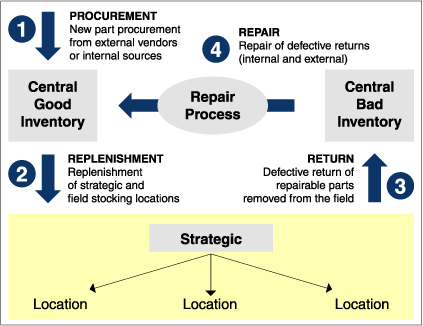Service Parts Supply Chain Pipelines
Servigistics is based on a typical service parts supply chain in that its infrastructure is made up of the following four, common pipelines.

Pipeline | Description | ||
|---|---|---|---|
Procurement | The Procurement pipeline feeds new parts into the service network from outside suppliers. | ||
Replenishment | The Replenishment pipeline transfers parts between locations within the service network. | ||
Return | The Return pipeline sends parts that have been removed from inoperable equipment to a repair facility. | ||
Repair | The Repair pipeline sends repaired parts back into inventory.
|
In order to optimize the service parts pipelines, Servigistics users go through the following high-level process steps.
1. Define the Business Organization
Servigistics staff works with your employees to define (and, in some cases, improve) your business organization.
2. Configure Servigistics
Servigistics is configured in such a way that the business targets set in step 1 are met.
3. Run the AutoPilot
The AutoPilot runs on a regular basis (usually nightly), based on the configurations developed in step 2, to process new information. The results of running AutoPilot processes are:
◦ Demand Forecasts
◦ Authorized Stocking Lists (ASLs)
◦ Optimal Levels
◦ Exceptions
◦ Recommendations
4. Work with the System Results
The system results generated in step 3 are used for business operation.